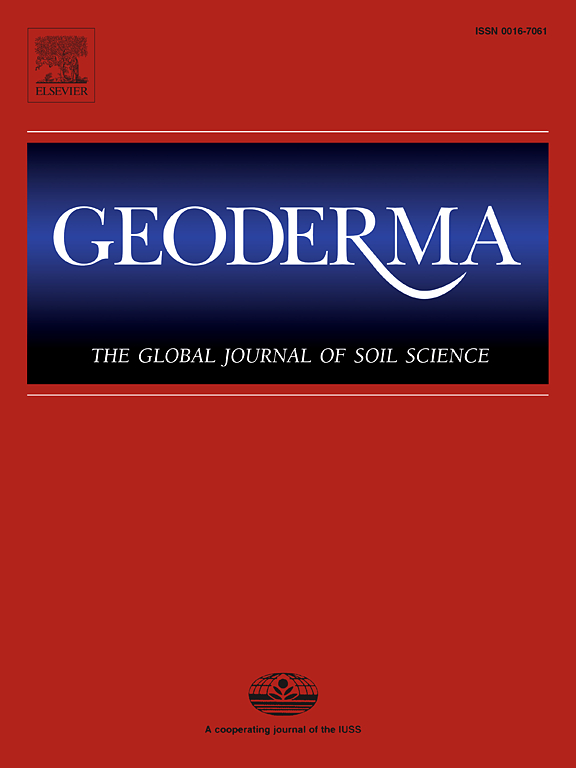草地退化与恢复过程中植物和微生物群落在生态系统多功能性中的独特作用
IF 6.6
1区 农林科学
Q1 SOIL SCIENCE
引用次数: 0
摘要
草原占地球陆地面积的三分之一,了解草原退化和恢复的机制对维持草原的健康至关重要。在草地退化和恢复过程中,植物群落对生态系统多功能性(EMF)的影响已得到广泛的研究,但土壤微生物群落的研究却很少。本项目研究了植物和土壤微生物群落在跨越3500公里样带的5个草地生态系统中调节EMF的作用。我们基于8个生态系统功能量化了EMF,并评估了其在天然草地、中度退化、重度退化、重度退化、短期围栏、中期围栏和长期围栏7个阶段的动态。结果表明,在草地退化过程中,细菌多样性的下降速度比真菌和植物多样性的下降速度要慢,EMF的下降主要是由植物多样性和多年生牧草丰度的减少所驱动的。在草地恢复过程中,细菌群落比植物和真菌群落恢复得快得多,成为EMF恢复的主要驱动力。结构方程模型确定了植物和微生物群落是EMF最重要的预测因子,即使在考虑了气候和土壤特性之后。土壤细菌多样性和优势细菌分类群(如放线菌、变形菌和Verrucomicrobia)的相对丰度是EMF恢复的关键决定因素。这些优势细菌分类群的功能冗余和弹性使EMF在不同气候条件下恢复一致。该研究为土壤微生物和植物群落在草地退化和恢复过程中驱动EMF动态的独特作用提供了有价值的见解。我们的研究结果强调了土壤细菌在草地恢复中的主导作用,表明未来的管理实践应优先考虑促进土壤细菌群落以促进草地恢复。本文章由计算机程序翻译,如有差异,请以英文原文为准。
Distinct roles of plant and microbial communities in ecosystem multifunctionality during grassland degradation and restoration
Understanding the mechanisms of grassland degradation and restoration is critically important for maintaining the health of grasslands, which occupy one-third of the planet’s land surface. Extensive research has focused on the impacts of plant communities on ecosystem multifunctionality (EMF) during grassland degradation and restoration, but soil microbial communities have been left out. This project investigated the roles of plant and soil microbial communities in regulating EMF across five grassland ecosystems spanning a 3,500 km transect. We quantified EMF based on eight ecosystem functions and assessed its dynamics during seven phases: natural grassland, moderate degradation, heavy degradation, severe degradation, short-term fencing, medium-term fencing, and long-term fencing. Our results showed that during grassland degradation, bacterial diversity declined more slowly than fungal and plant diversity, and EMF decline was primarily driven by reductions in plant diversity and the abundance of perennial forbs. During grassland restoration, the bacterial community recovered much faster than the plant and fungal communities, emerging as the primary driver of EMF recovery. Structural equation modeling identified plant and microbial communities as the most important predictors of EMF, even after accounting for climate and soil properties. Soil bacterial diversity and the relative abundance of dominant bacterial taxa (e.g., Actinobacteria, Proteobacteria, and Verrucomicrobia) were key determinants of EMF recovery. Functional redundancy and resilience of these dominant bacterial taxa enabled consistent EMF recovery across diverse climate conditions. This study provides valuable insights into the distinct roles that soil microbial and plant communities play in driving EMF dynamics during grassland degradation and restoration. Our findings highlight the dominant role of soil bacteria in grassland restoration, suggesting that future management practices should prioritize promoting soil bacterial communities to enhance grassland recovery.
求助全文
通过发布文献求助,成功后即可免费获取论文全文。
去求助
来源期刊

Geoderma
农林科学-土壤科学
CiteScore
11.80
自引率
6.60%
发文量
597
审稿时长
58 days
期刊介绍:
Geoderma - the global journal of soil science - welcomes authors, readers and soil research from all parts of the world, encourages worldwide soil studies, and embraces all aspects of soil science and its associated pedagogy. The journal particularly welcomes interdisciplinary work focusing on dynamic soil processes and functions across space and time.
 求助内容:
求助内容: 应助结果提醒方式:
应助结果提醒方式:


